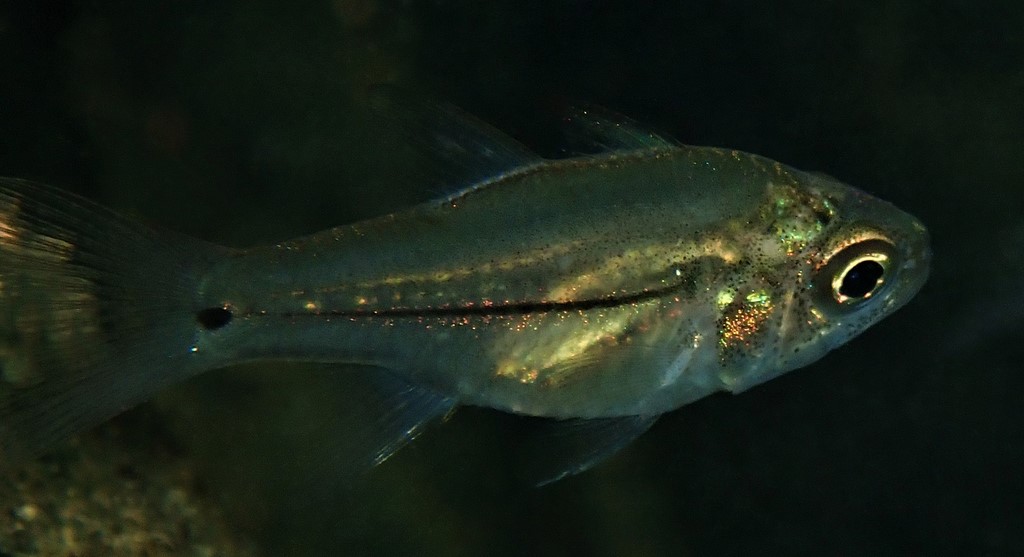FIBRAMIA LATERALIS - (VALENCIENNES, 1832)
Picture courtesy of: Alain Daoulas
Actinopterygii (Gigaclass) > Actinopteri (Class) > Teleostei (Subclass) > Gobiiformes (Order) > Apogonoidei (Suborder) > Apogonidae (Family) > Apogoninae (Subfamily) > Fibramia (Genus)
Pinstripe cardinalfish, Humpback Cardinal, Mangrove cardinalfish, Ceram cardinal, Coastal cardinalfish, Boggel-kardinaal, Wakiishimochi, ワキイシモチ, 侧条天竺鲷, 大目侧仔,
Synonymes
Amia lateralis (Valenciennes, 1832)
Apogon lateralis (Valenciennes, 1832)
Apogon literalis (Valenciennes, 1832)
Ostorhinchus lateralis (Valenciennes, 1832)
--------------------------
Description
Dorsal spines (total): 7; Dorsal soft rays (total): 9; Anal spines: 2; Anal soft rays: 8; Pectoral fin rays: 13-14. Last ray of second dorsal fin and anal fin not elongate. Villiform teeth on premaxillae and dentaries, in 1-2 rows on vomer and palatines. Gill rakers: 3-4 + 12-16. Median predorsal scales: 6-7. Deep bodied, head profile slightly concave. Greatest depth of body: 2.5-2.7 in SL. Max. length: 11.0 cm TL. Depth range: 0 - 3 m.
Color
Freshly dead fish semi-translucent tan, scales with narrow darkish margins, and thin dark line laterally, from opercle to small basicaudal spot; First spine and membrane of first dorsal fin blackish, third spine and part of membrane blackish, rest of fin translucent; Second dorsal fin and anal fin with faint stripe proximally; Caudal fin with darkish upper and lower edges. No stripe on snout, no small spot between dorsal fins.
Etymology
Fibramia: from Latin, fibra = fiber, filament + from Greek, amia, -as = a kind of bonito. Name given by Aristotle to a fish (Later name applied to Apogon by Gronow (1763), now a commonly used suffix in the family). Referring to two characteristics of the species in this genus, an elongate second dorsal spine in one species (Fibramia thermalis) and the narrow, pale or dark mid-line on the body of two species (Fibramia amboinensis and Fibramia lateralis).
lateralis: from Latin, latus = the side, flank + from Latin suffix, -ālis = adjectival suffix. Referring to fine black line running from shoulder to middle of tail.
Original description: Apogon lateralis Valenciennes, 1832 - Type locality: Vanikoro Island, Santa Cruz Islands, western Pacific.
Distribution
Indo-West Pacific: Mozambique, Seychelles, Aldabra (Seychelles), Comoros, Madagascar and Mascarenes (Mauritius) east to Caroline Islands (Micronesia), Tonga and Samoa, north to Ryukyu Islands (Japan), south to Western Australia, Queensland (Australia) and New Caledonia.
Biology
A euryhaline species, common in freshwater and estuaries, shallow sheltered inshore reefs or river mouths, among clumps of algae or algal covered rubble and in mangrove. The species is tolerant of a range of salinites. Found in aggregations. Mouthbrooders (males). Distinct pairing during courtship and spawning.
Similar species
Apogon ceramensis (Bleeker, 1852) - Reported from Indonesia, Papua New Guinea to Philippines. Silvery to slight golden sheen coloration; A narrow dark midlateral stripe; Black-edged first dorsal fin and a small black spot at the middle of caudal-fin base. It is similar to Fibramia lateralis but generally smaller (max. length: 8.0 cm TL) and the female has a small black spot behind the eye.
Apogon literalis (Valenciennes, 1832)
Ostorhinchus lateralis (Valenciennes, 1832)
--------------------------
Description
Dorsal spines (total): 7; Dorsal soft rays (total): 9; Anal spines: 2; Anal soft rays: 8; Pectoral fin rays: 13-14. Last ray of second dorsal fin and anal fin not elongate. Villiform teeth on premaxillae and dentaries, in 1-2 rows on vomer and palatines. Gill rakers: 3-4 + 12-16. Median predorsal scales: 6-7. Deep bodied, head profile slightly concave. Greatest depth of body: 2.5-2.7 in SL. Max. length: 11.0 cm TL. Depth range: 0 - 3 m.
Color
Freshly dead fish semi-translucent tan, scales with narrow darkish margins, and thin dark line laterally, from opercle to small basicaudal spot; First spine and membrane of first dorsal fin blackish, third spine and part of membrane blackish, rest of fin translucent; Second dorsal fin and anal fin with faint stripe proximally; Caudal fin with darkish upper and lower edges. No stripe on snout, no small spot between dorsal fins.
Etymology
Fibramia: from Latin, fibra = fiber, filament + from Greek, amia, -as = a kind of bonito. Name given by Aristotle to a fish (Later name applied to Apogon by Gronow (1763), now a commonly used suffix in the family). Referring to two characteristics of the species in this genus, an elongate second dorsal spine in one species (Fibramia thermalis) and the narrow, pale or dark mid-line on the body of two species (Fibramia amboinensis and Fibramia lateralis).
lateralis: from Latin, latus = the side, flank + from Latin suffix, -ālis = adjectival suffix. Referring to fine black line running from shoulder to middle of tail.
Original description: Apogon lateralis Valenciennes, 1832 - Type locality: Vanikoro Island, Santa Cruz Islands, western Pacific.
Distribution
Indo-West Pacific: Mozambique, Seychelles, Aldabra (Seychelles), Comoros, Madagascar and Mascarenes (Mauritius) east to Caroline Islands (Micronesia), Tonga and Samoa, north to Ryukyu Islands (Japan), south to Western Australia, Queensland (Australia) and New Caledonia.
Biology
A euryhaline species, common in freshwater and estuaries, shallow sheltered inshore reefs or river mouths, among clumps of algae or algal covered rubble and in mangrove. The species is tolerant of a range of salinites. Found in aggregations. Mouthbrooders (males). Distinct pairing during courtship and spawning.
Similar species
Apogon ceramensis (Bleeker, 1852) - Reported from Indonesia, Papua New Guinea to Philippines. Silvery to slight golden sheen coloration; A narrow dark midlateral stripe; Black-edged first dorsal fin and a small black spot at the middle of caudal-fin base. It is similar to Fibramia lateralis but generally smaller (max. length: 8.0 cm TL) and the female has a small black spot behind the eye.
Fibramia amboinensis (Bleeker, 1853) - Reported from New Caledonia - Link to the species (here). Similar to Fibramia lateralis but head profile concave versus convex aboves eyes.
Last update: 25, March 2023
Last update: 25, March 2023
